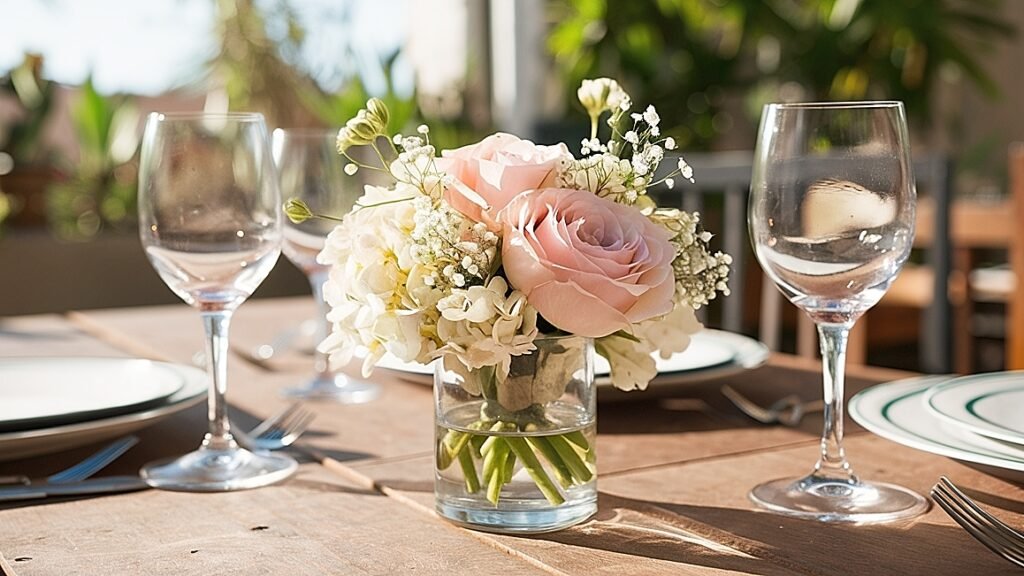
This website contains affiliate links, and some products are gifted by the brand to test. As an Amazon Associate, I earn from qualified purchases. Some of the content on this website was researched and created with the assistance of AI technology.
Key Takeaways:
- Use compact, low-profile vase shapes for small centerpieces
- Incorporate in-season blooms for optimal freshness and uniqueness
- Blend complementary colors and textures for visual interest
- Go for unexpected, repurposed vessels to add rustic charm
- Include edible garnishes like herbs or fruit for multisensory appeal
- How to Create Floral Centerpieces for Small Gatherings
Whether you’re hosting an intimate dinner party or a casual get-together with just a few close friends, fresh floral centerpieces have a way of elevating the occasion. But all too often, arrangements meant for grand banquet halls or ballrooms end up overwhelming a small table’s cozy ambiance. As a lifelong florist specializing in hospitality designs, I’ve fine-tuned the art of compact yet lushly textured centerpieces tailored for modest gatherings.
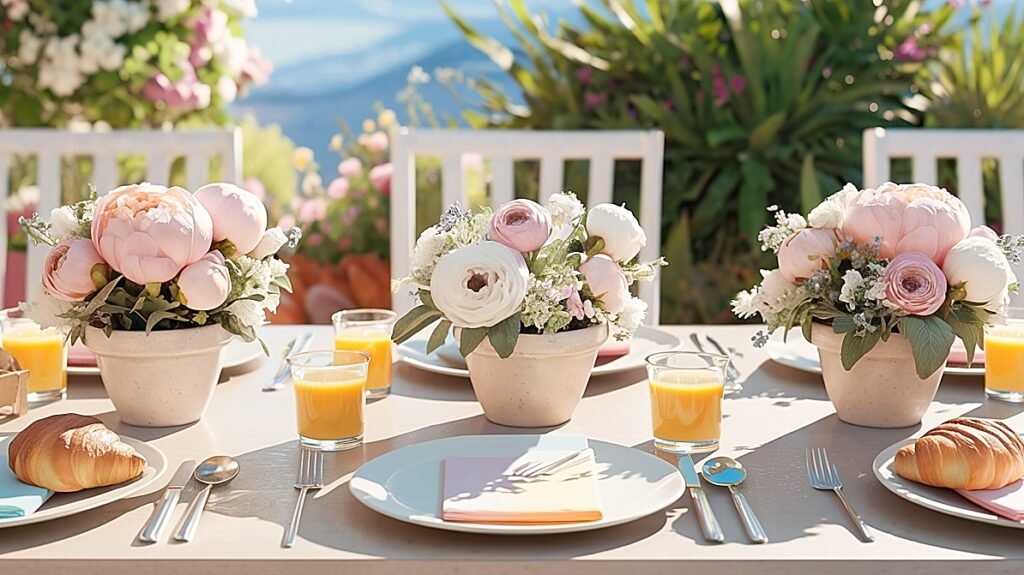
These diminutive displays pack a major visual punch without distracting from quality face time with your guests. From selecting appropriately scaled rose blooms from your own patio and vase shapes to experimenting with unique seasonal accents, I’ll walk you through my personal tried-and-true tips for crafting one-of-a-kind small floral statements infused with artisan flair. Your intimate fêtes are about to get a luxe yet totally approachable makeover!
After all, some of the most thoughtfully curated tablescapes I’ve ever designed were for esteemed clients hosting limited-seating occasions. By leaning into floral minimalism and embracing subtle elegance over grandiose opulence, you can absolutely create striking centerpieces worthy of life’s most meaningful moments. Even if it’s simply treating yourself to a solo candlelit dinner for one – because you deserve to dine surrounded by botanical beauty too!
Here are some suggestions on choosing the best floral centerpiece style based on your compact table shape.
Centerpiece Styles by Table Shape
Round Table
Compact circular arrangements with uniform heights work best for round tables.
Rectangular Table
Long, linear arrangements or a series of small vases create balance on rectangular tables.
Square Table
Centralized, symmetrical centerpieces add focus and elegance to square tables.
How to Choose the Right Vase for a Small Gathering?
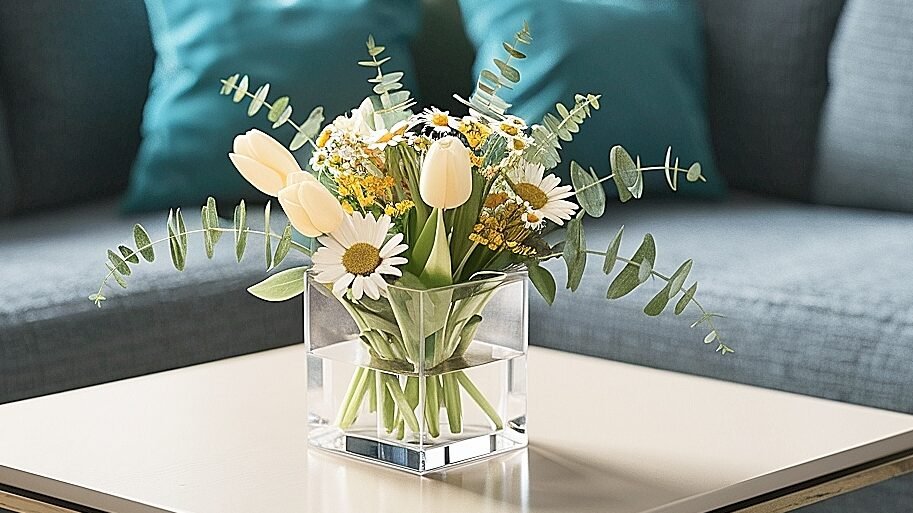
While traditional towering centerpiece vessels undeniably make a dramatic statement for large banquet tables or expansive open floor plans, these sky-high glass cylinders and compotes are usually a bit too overpowering when it comes to intimate dining settings. Not only do their statuesque profiles obstruct precious face-to-face conversation, but their grandiose statures can actually dwarf the very surfaces they’re supposed to be embellishing.
Instead, for cozy cocktail tables or compact square or circular tabletops where every inch of real estate is prime hosting real estate, you really want to stick to low, wide-mouthed vases and containers that allow guests’ lines of sight to easily connect across the table. Shallow ceramic bowls overflowing with lush botanicals, glazed bud vases clustered together, or horizontally oriented gardening vessels all make for chic petite centerpiece options.
My go-to move is sourcing vintage glass bricks, tarnished silver trays or even aged wooden boxes from antique shops, then lining the interiors with humidity-proof supplies to craft one-of-a-kind mini arrangements. Not only do these unexpected yet purposefully diminutive containers add oodles of organic charm, but the uniqueness sets an immediate tone of intimacy before guests even arrive. It’s like extending a warm, individualized invitation to an evening of thoughtful hospitality from the very first centerpiece impression.
Small Gathering Vase Style Quick Reference Chart
| Vase Shape | Ideal Bloom Count | Table Size | Visual Impact |
|---|---|---|---|
| Cylindrical | 6-10 | Small/Medium | Clean, Modern |
| Bud Vase | 1-3 | Compact | Minimal, Delicate |
| Fishbowl | 3-5 | Medium | Soft, Round |
Check out my curated selection of Compact & Sweetly-Scaled Vase Designs for more inspo! And as a savvy hosting pro, I’d be remiss not to remind you to share this blog with your entertaining crew for future floral masterclass sessions.
What Flowers Are Best for Small Floral Centerpieces?
- Roses (traditional, romantic, available year-round)
- Peonies (lush, blousy, short-lived seasonal showstoppers)
- Spray Roses (petite, cost-effective, prolific bloomers)
- Ranunculus (fluffy pom-pom blooms in vibrant shades)
- Tulips (elegant, long-lasting with a variety of shapes)
When it comes to selecting the ideal floral ingredients for intimate tablescapes and centerpieces, you really want to gravitate toward smaller bloom varieties that make a major visual impact without overwhelming a modest surface area. This allows your displays to feel lush and full while still affording ample open real estate for place settings and serving dishes – not to mention line-of-sight for cross-table conversation.
Versatile, ever-present rose varieties will always have a spot in my heart (and my designs!) thanks to their compact yet romantic flower heads, availability year-round, and sheer diversity of colors and forms to fit any aesthetic. But I also adore splurging on opulent seasonal showstoppers like peonies and garden roses for short-lived tablescapes meant to be relished in the moment.
Cost-effective floral workhorses like spray roses, ranunculus, tulips, and hyacinth afford a prolific pop of color and textural interest for budget-friendly yet bountiful small centerpieces too. I love mounding fluffy ranunculus blooms inside low-profile vessels for a fresh take on classic domed centerpiece domes, or opting for lush, blowsy tulip varieties for a more modern structural vibe.
How to Incorporate Seasonal Flowers into Small Centerpieces?
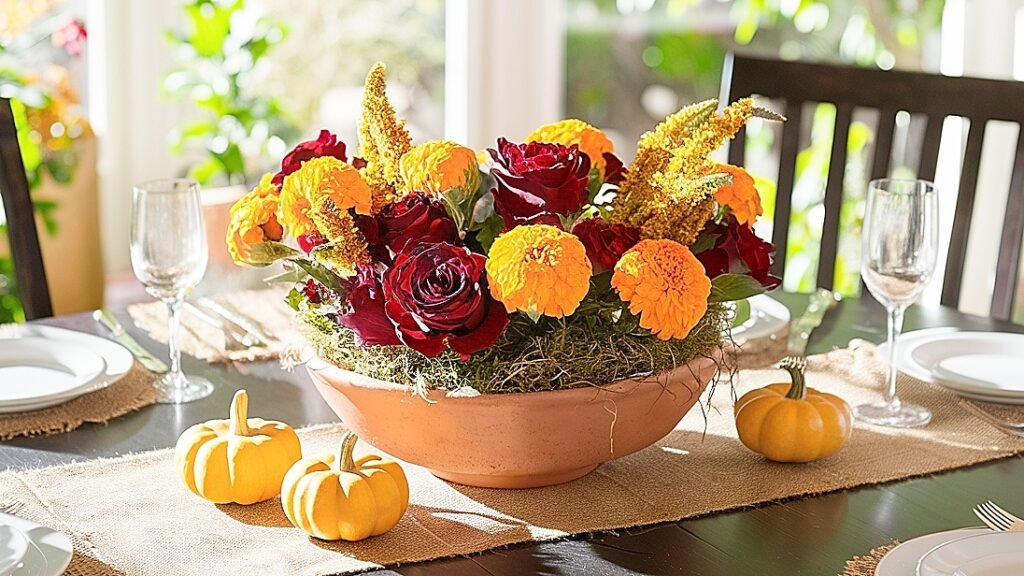
While centerpiece classics like roses and ranunculus remain readily accessible year-round through professional floral suppliers, there’s nothing quite like layering in a few ultra-fresh, locally-grown seasonal picks to capture the true essence of each passing month. These delightfully ephemeral stems have a way of grounding petite arrangements with undeniably of-the-moment flair while capitalizing on superior quality and availability.
Come springtime, we’re talking about luxuriating in all those deliciously fragrant flowering branches like quince, forsythia, hellebores and spring-flowering cherry. As summer’s balmy days set in, swapping in bulb flowers like daffodils alongside butterfly ranunculus and heavenly garden roses creates an intoxicatingly romantic vibe. Autumnal tablescapes take on an entirely new persona thanks to seasonal darlings like dahlias, zinnias, sunflowers and feathery celosia plumes. And for winter’s darkest months?
Burgundy hypericum berries, contorted willow tips, silvery brunia, velvet amaranthus and jewel-toned anemones suddenly feel soirée-ready all over again!
Those hyper-local, seasonal accents have a certain magic for adding authenticity, unbeatable freshness and capturing each month’s unique color narrative in small centerpiece designs. And trust me – showcasing those coveted florals’ extremely limited availability speaks volumes about your taste and dedication as a host! For more tips on creating charming seasonal centerpieces, be sure to keep reading.
What Rose Colors Work Best for Small Floral Centerpieces?
- Soft Peach Roses (warmth, romance, sweet garden charm)
- Berry-Toned Roses (regal, dramatic, irresistibly lush)
- Golden Roses (cheerful, sun-kissed, glowing tones)
- Blush Roses (elegant, understated, delicate femininity)
- Lavender Roses (soft, whimsical, wonderfully unique)
While I generally encourage embracing the entire vivid rainbow spectrum when it comes to floral design, there’s no denying that certain rose colors simply lend themselves better to intimate tablescapes and compact centerpiece displays than others. Specifically, you’ll want to veer away from extremely bold, overpowering hues that come across too vibrant or jarring in close quarters.
Instead, look for rose varieties featuring softer, more romantic tones and subtle color variations to create that desired atmosphere of casual elegance. Think velvety, rich berry and burgundy shades offering moody drama without being too deep or dark. Blush-toned garden roses are also swoon-worthy, infusing tablescapes with an air of delicate femininity.
Warm peachy-golden roses make for naturally sun-kissed displays brimming with sweet, effervescent cheer. While lavender and purple rose varieties bring an intriguing hint of whimsy and unconventional flair to centerpiece designs. No matter which soft, inviting color direction you choose, I’d highly recommend leaning into interesting tonal variations and ombré effects by blending multiple saturations of the same rosy hue.
For even more rose color guidance, reference this in-depth Rose Varietal Guide I’ve meticulously compiled over the years! Then do me a favor and tell your flower-loving friends to hop aboard the small centerpiece train too.
What Vessels Add Unique Charm to Small Centerpieces?
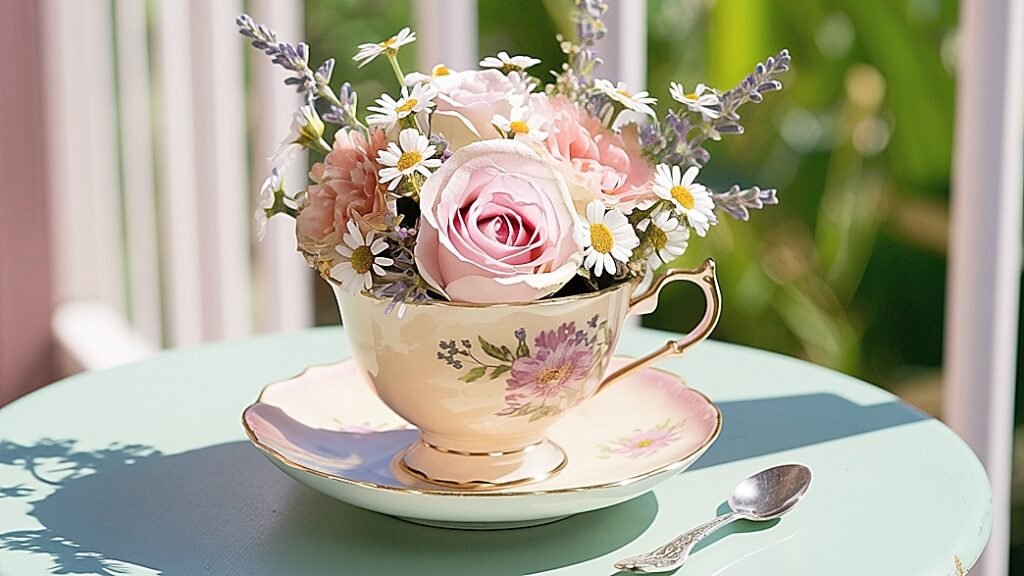
- Aged Metal Pitchers (rustic farmhouse allure, burnished patinas)
- Milk Glass Containers (vintage cottage charm, subtle luster)
- Cut-Glass Bowls (elegant etched brilliance, heirloom romance)
While I’ll always adore a pristine glass cylinder or modern ceramic vase for housing elegant rose centerpieces, part of the fun in designing for intimate gatherings is getting creative with unconventional display vessels! These delightfully unique containers have a certain knack for injecting extra personality, nostalgic charm and stylistic flair into petite arrangements.
For couples and hosts drawn to rustic, countryside-inspired aesthetics, few display mediums radiate as much effortless romance as repurposed vintage tins in aged hues like sage, powder blue or butter yellow. There’s simply something so alluring about those old-fashioned botanical prints, advertisements and hand-stenciled typography peeking through lush floral accents, making them perfect fits for farmhouse tablescapes or outdoor garden fetes.
Those leaning more traditional might favor the understated, artisanal sophistication of ceramic or earthenware bowls and compotes. Their handcrafted, organic shapes and subtly textured glazes cast an unmistakably romantic, antiqued yet timeless ambiance that uplifts any lush rose centerpiece with unmatched elegance. Plus, those broad silhouettes provide tons of room for lavish floral overflows!
And for anyone craving an extra dash of rustic, naturalistic texture blended seamlessly with tailored floral arranging, you must try hand-woven baskets next time! Their gently curved profiles and wicker weaves provide a gorgeous counterpoint to soft rose petals and trailing vines for an earthy, garden-inspired feel. These undeniably dreamy vessels look simply sublime whether overflowing with abundant rose bundles or tastefully housing a few minimalist blooms. It’s that juxtaposition of raw materials and lavish botanicals that makes them so visually compelling.
What Are the Best Compact Arrangements for Coffee Tables?

Let’s be honest – while we’ve already covered optimizing centerpiece designs for intimate dinner tables, many modern hosting occasions call for even more casual, low-profile flower arrangements suited for coffee tables, side tables and casual lounge settings. These pint-sized displays need to feel visually impactful yet totally laid-back and never overwhelming.
One of my tried-and-true go-to’s is opting for a tidy, compact grouping of low cylinder vases, each containing a single varietal bloom like a lush garden rose or subtly-hued hydrangea. By keeping each vessel monochromatic with a botanical variation on a single color concept, you create cohesion. But the multilevel, clustered effect looks effortlessly chic and sculptural without seeming too contrived.
You can always introduce extra textural flair by integrating unique foraged elements like seeded eucalyptus or curly willow branches spilling over the sides. For added dimension, incorporate a vintage brass candlestick or two amid the grouping as well.
Another fresh coffee table centerpiece approach I adore is using long, vintage wooden containers or window boxes for creating a linear floral “runner” of vibrant blooms. These narrow, low-profile arrangements lend eye-catching appeal to coffee tables without any height to obstruct conversation flow. Introduce a mix of flower types, colors and coordinating botanical accents for whimsy!
How to Incorporate Edible Elements into Floral Centerpieces?
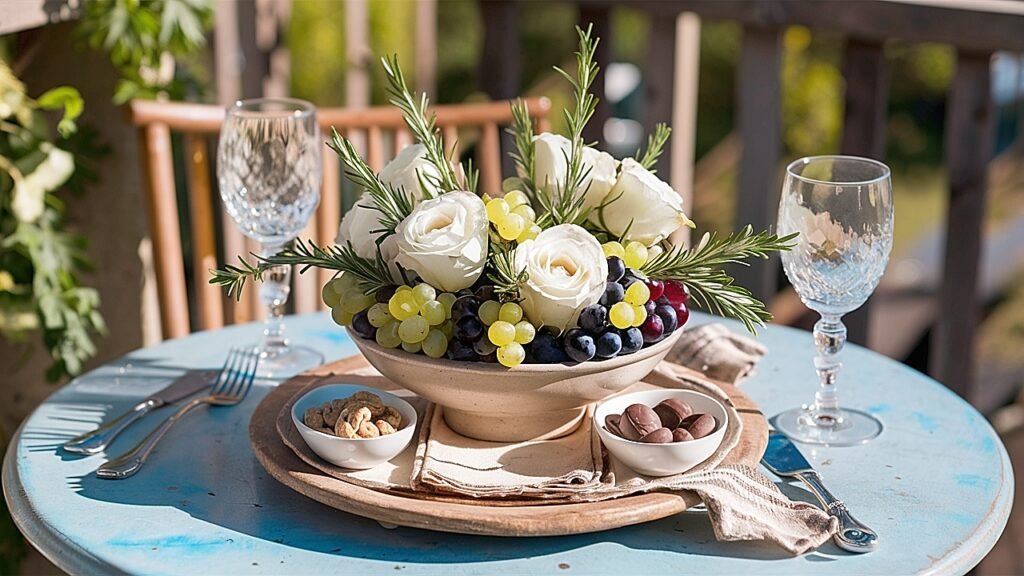
In my endless pursuit of multisensory designs that engage all the senses beyond just visual artistry, I’m constantly experimenting with unexpected ways to introduce edible touches to centerpieces and tablescapes. Not only do fresh herbs, fruits and even veggies enhance arrangements with their vibrant hues and textural allure, but they perfume the air with deliciously appetizing aromas too.
Simple yet high-impact ideas? Tuck sprigs of fragrant rosemary, lavender or sage amid lush rose centerpieces for an herbal element. Or allow ruby-red pomegranates or glossy figs to peek through a glass cylinder vase brimming with greenery like ivy vines. A few clove-spiked whole citrus fruits like lemons or limes can lend zest to monochrome white centerpiece designs as well.
For coffee table centerpieces, I often adorn budvase collections with scattered flower petals intermingled with loose blueberries, pink peppercorns or even espresso beans. You get coordinating colors plus an unexpected organic texture adding to the visual narrative. And how’s this for an elevated twist – snipping fresh herbs like basil over warm candlewax instantly spices up the air with their complex essential aromatics.
Of course, you could also just straight-up fill rustic wooden bowls with colorful arrays of whole heirloom produce like artichokes, grapes, plums, and lady apples. Allow wispy fennel fronds or flowering vines to billow over the sides and voila – an undeniably lush, farm fresh centerpiece dripping with artisanal flair!
For more ideas on using unexpected edible accents, reference my blog on A Chef’s Guide to Edible Florals & Garden Garnishes. Your guests’ appetites (and all their senses!) are sure to be tantalized.
Conclusion
Well, there you have it, dear flower friends – a crash course in meticulously crafting charismatic yet compact floral centerpieces that’ll instantly elevate your intimate hosting affairs. From sourcing seasonal blooms reflecting each distinct growing season to forgoing ubiquitous clear glass vessels for far more intriguing antique and repurposed treasures, no detail is too small when it comes to infusing your tablescapes with true artisan flair.
Remember, the real key to one-of-a-kind centerpiece designs for smaller surface areas lies in a careful balance of bloom sizes, vase proportions, heights, textures and colors. Build interest and movement through strategic groupings, varying levels, and blending lush organic accents with unexpected edible touches.
But most importantly, don’t get mired in overthinking it. Let petite arrangements organically reflect your personal hosting aesthetic and the overall mood you wish to convey. From cheerful sun-drenched rosebowls to moody autumnal vessels brimming with berries and vines, the only true rule is letting your garden-fresh inspirations take the creative lead.
So have fun floral foraging your farmer’s markets and local growers, scour thrift shops for conversation-starting containers, and most importantly – embrace the art of intimate botanical storytelling. Because even the most laid-back brunch or low-key potluck deserves a beautifully composed centerpiece setting the tone from the moment guests enter the space.
This website contains affiliate links, and some products are gifted by the brand to test. As an Amazon Associate, I earn from qualified purchases. Some of the content on this website was researched and created with the assistance of AI technology.
